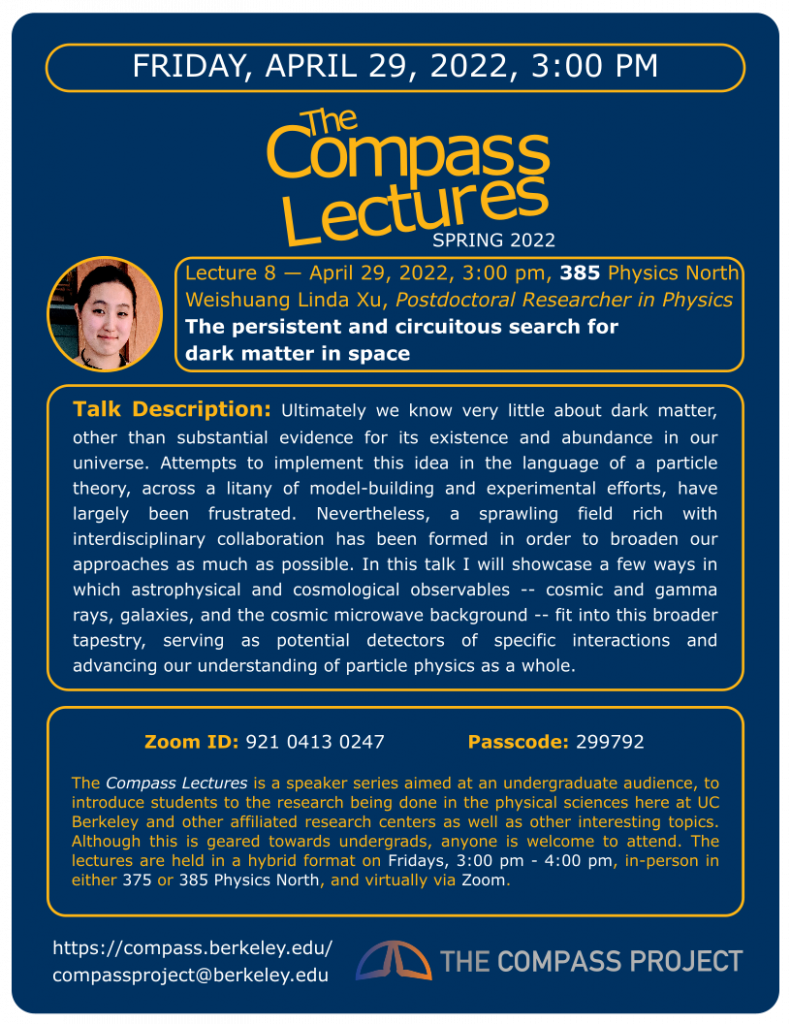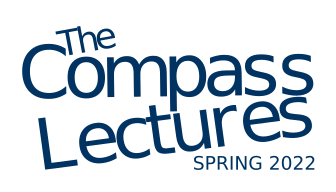
The Compass Lecture Series is a collection of research talks given by Berkeley physical sciences faculty or PhD candidates who are about to graduate. These talks are unique in the Berkeley Physics Department in that they are designed for an undergraduate audience. The goal of the lecture series is to introduce undergrads to as many areas of research as possible using language and physics concepts they can understand. Undergraduates interview and introduce the speakers and manage the question-and-answer period that follows the talk. The lectures take place on the Fridays listed below at 3:10 PM (AKA 3PM Berkeley time) in 375/385 Physics North.
The Spring 2022 Lectures:
Lecture 1 (Friday March 4th, 2022):
Probing The Standard Model with Atom Interferometry
Lecture 2 (Friday March 11th, 2022):
Watching a Star Explode with the Young Supernova Experiment
Lecture 3 (Friday March 18th, 2022):
Illuminating the Black Box of Machine Learning
Lecture 4 (Friday April 1st, 2022):
Chance and Probability in Microbial Evolution
Lecture 5 (Friday April 8th, 2022):
Lecture 6 (Friday April 15th, 2022):
Cosmic Inflation: A Window Into Ultra High Energy Physics
Lecture 7 (Friday April 22nd, 2022):
Finding clues to planet formation and evolution in multi-planet systems
Lecture 8 (Friday April 29th, 2022):
The persistent and circuitous search for dark matter in space
Probing The Standard Model with Atom Interferometry
Madeline Bernstein, Graduate Student in Physics
Date & Time: Friday, March 4, 2022, 3:00 pm – 4:00 pm
Location: 375 Physics North
Talk Description: The fine structure constant, also called alpha, is a fundamental constant of the standard model that represents the strength of electromagnetic interactions. Recent discrepancies in its measured value motivate a more precise measurement. Interferometry uses the interference effects of waves to make precise measurements of small quantities. Atom interferometry interferes matter waves rather than light waves, taking advantage of the particle-wave duality of nature. My experiment uses atom interferometry to precisely measure alpha by measuring the recoil velocity of an atom after absorbing a photon. This is done with an atomic fountain, where atoms are launched into a freefall trajectory, and sent into a quantum superposition of momentum states.
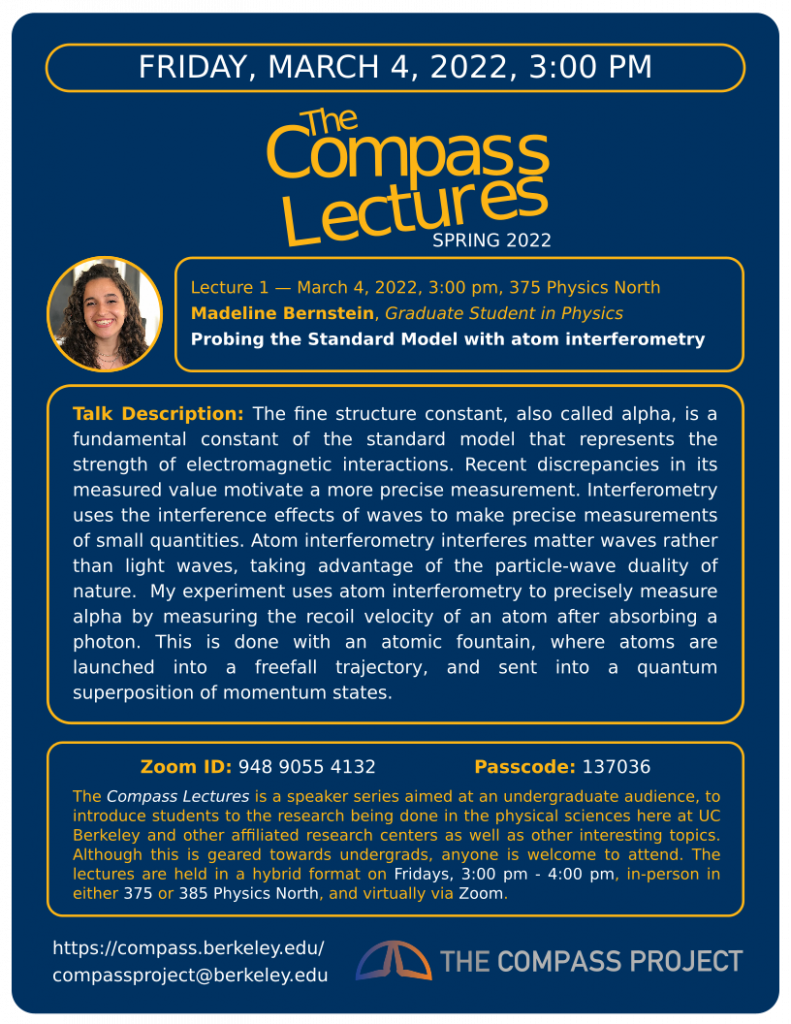
Watching a Star Explode with the Young Supernova Experiment
Wynn Jacobson-Galan, Graduate Student in Astrophysics
Date & Time: Friday, March 11th, 2022, 3:00pm – 4:00pm
Location: 375 Physics North
Talk Description: In Summer 2020, the Young Supernova Experiment (YSE) sky survey, using the Pan-STARRS telescope on Haleakalā, discovered a red supergiant star in its final death throes before explosion. What YSE saw was luminous emission coming from a massive star in its final year of life before it violently collapsed and exploded as type II supernova 2020tlf, discovered in Fall 2020. The detection of this “precursor emission” or “pre-supernova activity” in a red supergiant star has never been observed before in a type II supernova (i.e., an explosion of a red supergiant star) and represents a breakthrough in our understanding of what these massive stars do moments before they die. In this talk, I will discuss the implications of this finding as well as describe what we learned from the explosion itself through a multi-year observing campaign with multiple telescopes around the world. Lastly, I will discuss future prospects for finding luminous pre-explosion emission from red supergiants with upcoming sky survey telescopes such as the Vera Rubin Observatory.
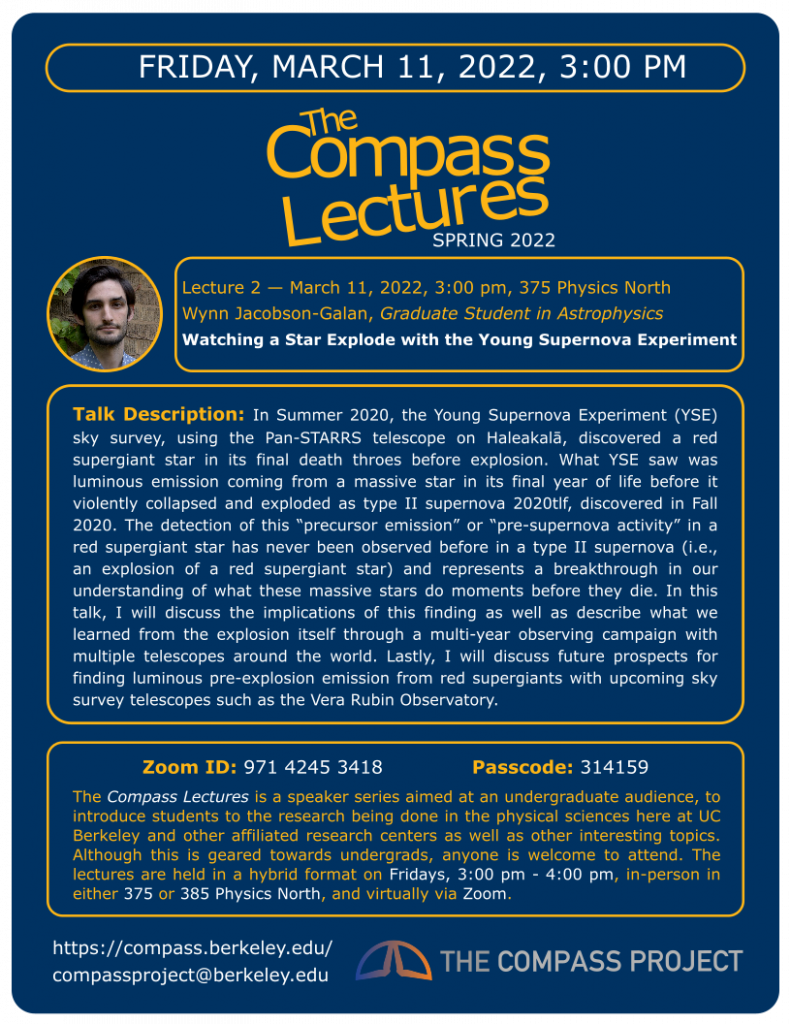
Illuminating the Black Box of Machine Learning
Jamie Simon, Graduate Student in Physics
Date & Time: Friday, March 18th, 2022, 3:00pm – 4:00pm
Location: 375 Physics North
Talk Description: Machine learning – the use of complex algorithms to find patterns in data – has enabled technological miracles. The most powerful ML algorithms are called “neural networks,” and they’re behind Siri, Google Translate, and Tesla Autopilot. What if I told you, then, that despite these successes, we don’t fundamentally understand how they work?
For reasons of both fundamental science and future technology, I think understanding neural networks is one of the most important questions in science today. I’ll outline the problem, show some of my recent work shining light on the inner workings of these black box algorithms, and explain why, though this challenge isn’t traditional physics, it’s certainly a job for physicists.
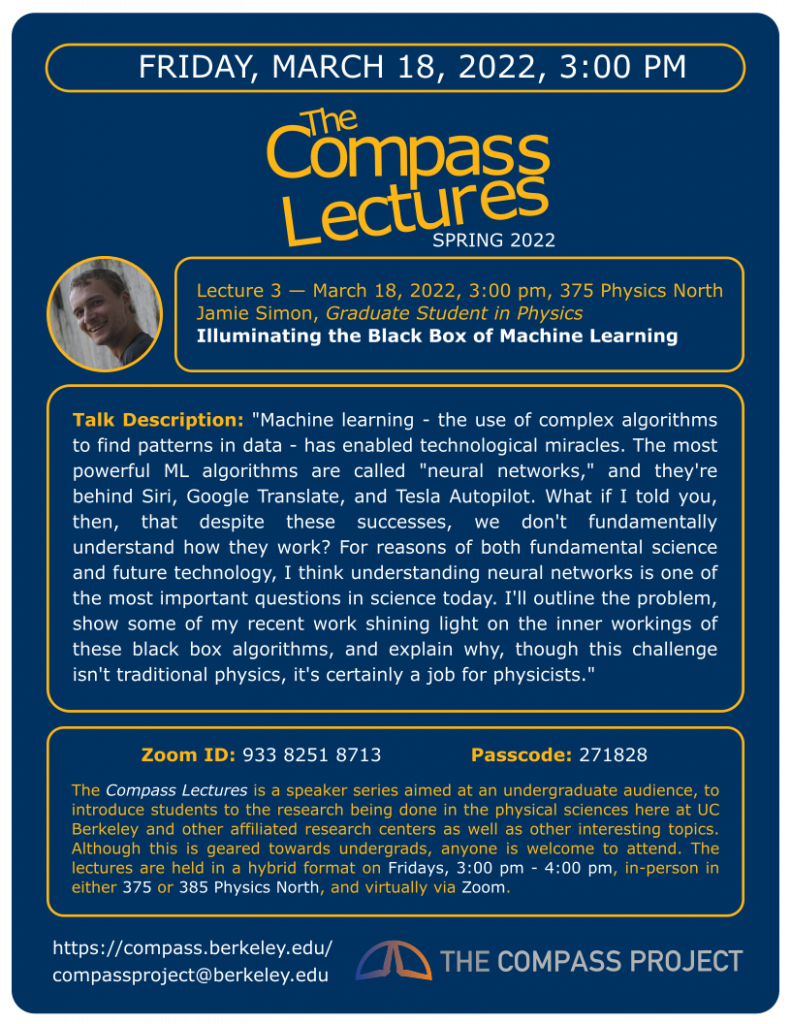
Chance and Probability in Microbial Evolution
QinQin Yu, PhD Candidate in Physics (Quantitative Biosciences)
Date & Time: Friday, April 1st, 2022, 3:00pm – 4:00pm
Location: 385 Physics North
Talk Description: Microbes are everywhere, from fermented foods to thermal hot springs, human microbiomes, and human pathogens. Microbes can evolve – or change their genetic material to adapt to the environment – extremely fast. Understanding the processes that drive microbial evolution will help us to better control them when they are harmful, and leverage them when they are helpful. To do this, we have to take into account the role of chance, or probability, in evolution. How does chance play a role in evolution, what consequences does it have, and what are scientists still learning about it?
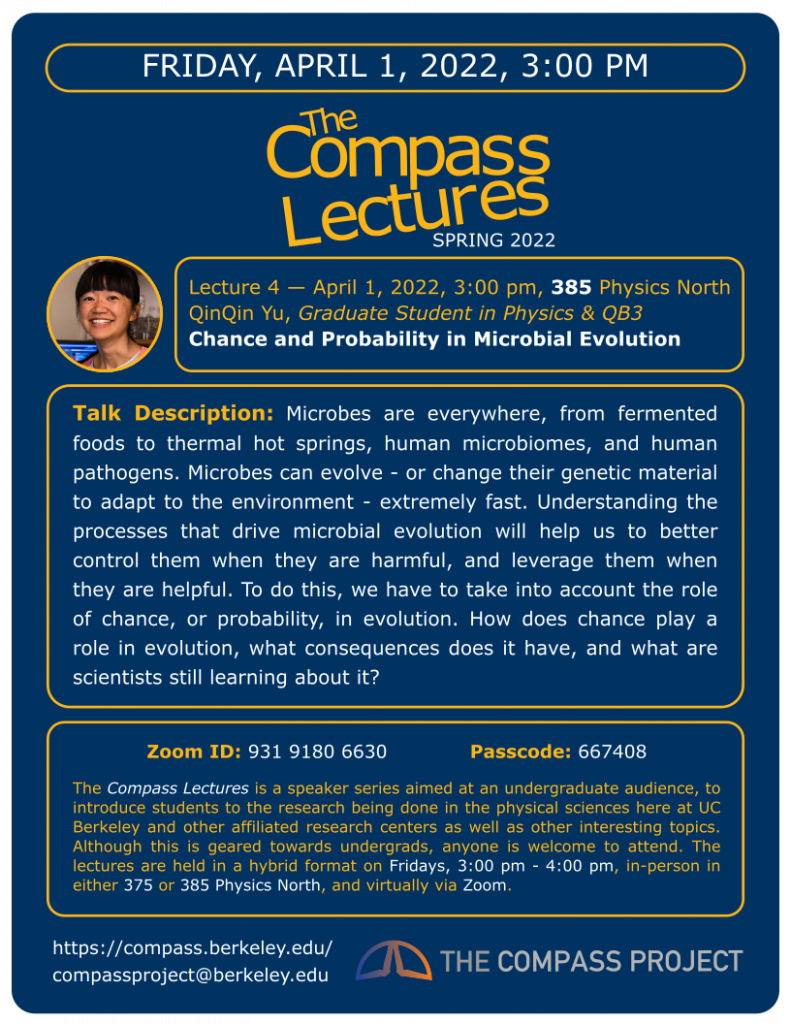
Topology in Condensed Matter
Koh Yamakawa, PhD Candidate in Physics
Date & Time: Friday, April 8th, 2022, 3:00pm – 4:00pm
Location: 375 Physics North
Talk Description: Topology is the spice of life.
In condensed matter, it can arise in the form of properties that are guarded against physical changes. Topology can allow exotic things to happen: electrons can splinter, magnetism can break, and particles that exist in a state between fermions and bosons can come into existence. Let’s explore the world of topology and see how materials can bring to life a zoo of other-worldly phenomena.
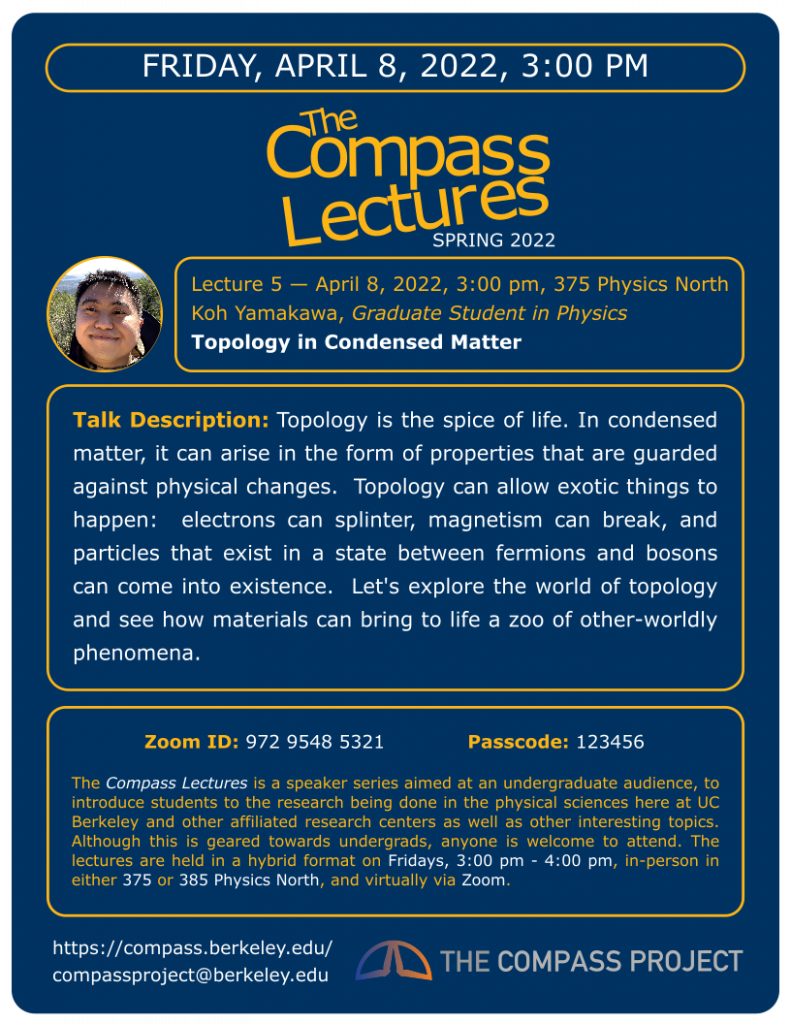
Cosmic Inflation: A Window Into Ultra High Energy Physics
Soubhik Kumar, Postdoctoral Researcher in Physics
Date & Time: Friday, April 15th, 2022, 3:00pm – 4:00pm
Location: 375 Physics North
Talk Description: Cosmic Inflation, a period of rapid expansion in the very early Universe, is believed to be the primary mechanism for sourcing the cosmological structure around us, such as in the distribution of galaxies. Given the energy scale during inflation can be a billion times higher than what can be directly probed at terrestrial experiments, I will discuss several cosmological observables that let us study particle physics at those ultra-high energies in a unique manner.
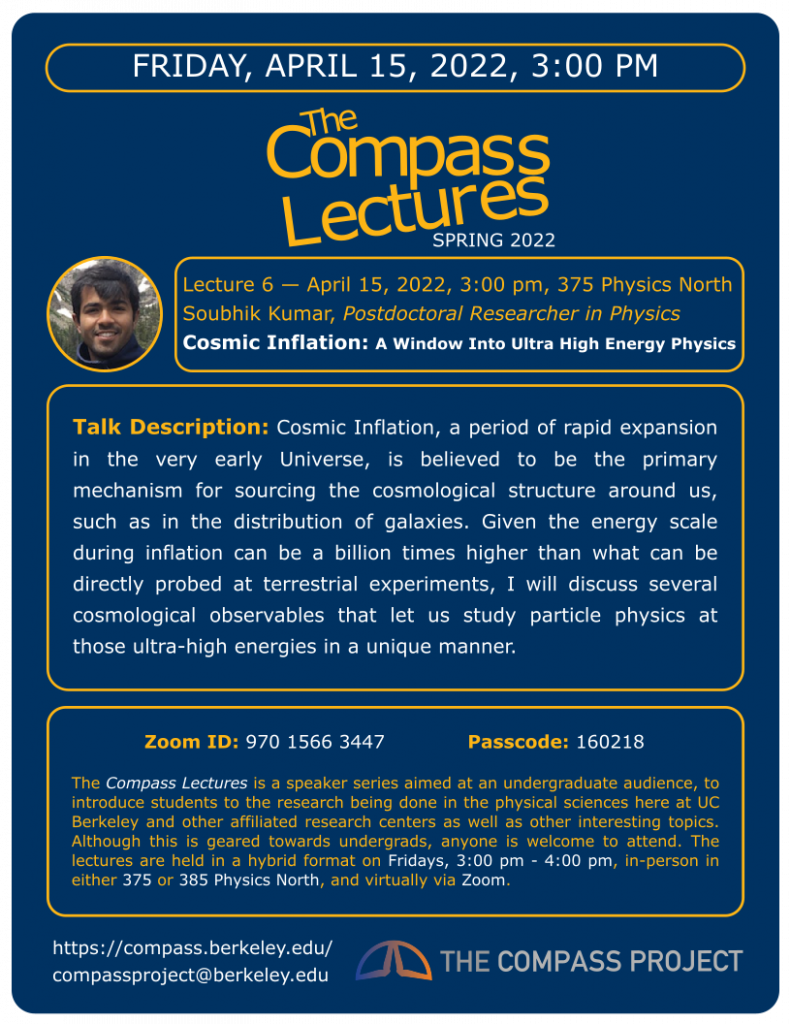
Finding clues to planet formation and evolution in multi-planet systems
Emma Turtelboom, Graduate Student in Astronomy
Date & Time: Friday, April 22nd, 2022, 3:00pm – 4:00pm
Location: 375 Physics North
Talk Description: We have come to learn that there are thousands of planets beyond the Solar System. Some of these planets are in multi-planet systems, with multiple planets orbiting a single star. I will discuss one such system, called TOI-1246, which has four Neptune-sized planets. By measuring the masses and radii of these planets, we can learn about their compositions and atmospheres. I will then extend this discussion to all multi-planet systems and how we can learn about their formation and evolution. By observing planetary systems of different ages, we hope to reveal the mechanisms of planet formation.
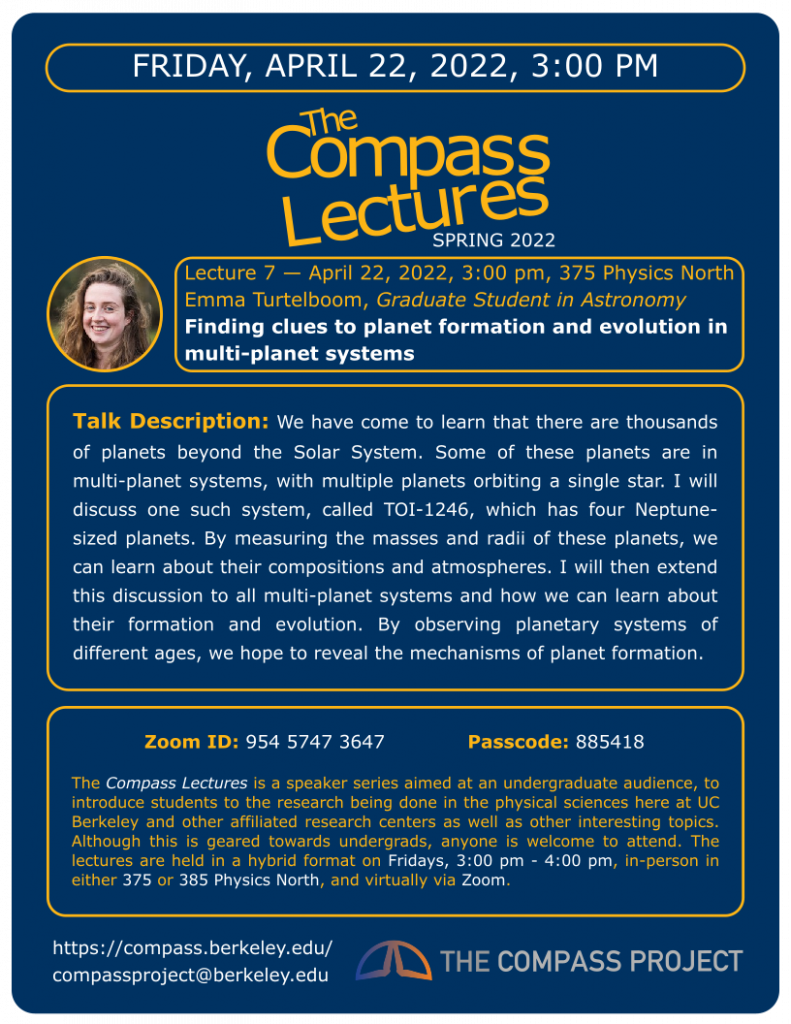
The persistent and circuitous search for dark matter in space
Weishuang Linda Xu, Postdoctoral Researcher in Physics
Date & Time: Friday, April 29th, 2022, 3:00pm – 4:00pm
Location: 385 Physics North
Talk Description: Ultimately we know very little about dark matter, other than substantial evidence for its existence and abundance in our universe. Attempts to implement this idea in the language of a particle theory, across a litany of model-building and experimental efforts, have largely been frustrated. Nevertheless, a sprawling field rich with interdisciplinary collaboration has been formed in order to broaden our approaches as much as possible. In this talk I will showcase a few ways in which astrophysical and cosmological observables — cosmic and gamma rays, galaxies, and the cosmic microwave background — fit into this broader tapestry, serving as potential detectors of specific interactions and advancing our understanding of particle physics as a whole.
